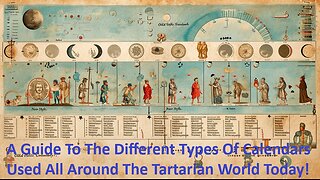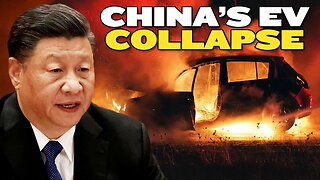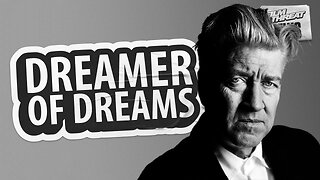Premium Only Content

Chilaga Where Chicago Is Now On Map of America and 1893 World’s Columbian Exposition
There are many maps that clearly show the name CHILAGA in the exact same location as where Chicago would be 250 years prior. In the 1890s, a Newspapers Article from the Chicago Tribune covered this topic but only 6 days later a response was issued in order to cover up this subject. Is it because they don't want people to know that Chicago is actually much older and was established by the Tartarians and NOT by the European colonist in the 1800s. When we connect this with the Chicago World Fair things start to make a lot more sense... This map has Chilaga where Chicago is now Map of America or the New World in 'Theatrum Orbis Tearrarum' by Abraham Ortelius, 1570 Old Map from Great Lake Area A City is Named > Tartaria > Shikaakwa > Checagou > Chicago > So Maybe the History we've been told is a lie! Were some ancient buildings built by a different race and their true history was covered up?
In 1893 the city of Chicago held the World's Colombian Exposition to publicly celebrate Columbus 'discovering' America. The fair's promoters "...hoped to demonstrate the great industrial power of the United States and symbolize the passing of leadership from the Old World to the New." It was, perhaps, really a celebration of the destruction of the great Tartarian city of Chilaga (Chicago).
You are to believe that more than 200 new buildings over 600 acres were erected on a reclaimed swamp in two years from the start of planning to opening day.
Furthermore, there are no blueprints and documentation is sparse, nearly everything was said to be built with plaster of Paris, it was completed during the Great Economic Panic of 1893, and nearly everything was destroyed after only six months of having been opened.
The total population of the United States in 1890 was 62,979,766. The top 10 largest cities held 10.6% of this population and the top 100 cities accounted for 21.2%. New York had a population of 1,515,301 while Chicago had 1,099,850 and Philadelphia had 1,046,964. A number equal to half of the entire population of the US came to see the destruction of Chilaga from the Old World, and 1893 World’s Columbian Exposition some 27 million people from all over the world.
Tartary's symbol of freedom and liberty, the so-called Statue of the Republic. In here left hand she holds a symbol of the common people, the 'phrygian cap'. In her right hand is a griffin atop a sphere.
How did 10,000 unskilled workers build 200 marvelously incredible buildings? Not just that, but they built them in 2 years. They are said to be built temporary, but this book shows that they were in fact built with material such as Iron, Steel, Glass and Wood. Is there more to the story that we aren't being told? In any case, it was a marvelous feat of architecture and planning.
Another good point to mention is that nearly all modern structures today are technically still temporary. We still use wood, lumber, stucco and plaster and call it permanent when it's not. I've been a part of large construction buildings, like a 24 story hotel, and many residential houses. It is not possible to do this today.
Even of we had unlimited money, technology and employed half the country. It's not possible to re-create that area in 2 years. It doesn't matter if it's stucco and plaster or cast geopolymer. Even the entire human population would struggle to achieve this. There are only so many people that can fit in an area and work.
There are only half of the days in a year to work outside. In 1892-1893, Chicago had its coldest winter on record, with an average temperature of 22.5°F during the December-March period. Also there still has to be people doing farming and every other kind of work to support society. Plus lumber takes time to cut and cure before it can be used. Where does all this material come from without infrastructure to produce and transport it?
Where did all the steel and glass come from? How many workers would it take to complete the crystal palace in two years. I was mind blown by that when I was a child, and I explored every nook and cranny of the buildings that remained - amazed by the artistry and masonry. I would ask my mother why we didn't build buildings like that anymore, especially when we had such big machines and power tools. No one could answer me, and I moved on to other interests, but the old questions were always open and unanswered.
My great grandparents met at the Chicago World's fair, and my grandmother, a younger sibling, was born in 1898 or 1899. It was funny that she didn't know for sure. I wish I had thought to ask her if her parents had told her anything about the fair. I don't think I ever asked her more than what it was like to see the first airplanes. She didn't talk much about the technological past, being more concerned with familial things, but I think she didn't regret the replacement of horses and all their dung in the streets. They really did seem to live a rural lifestyle even in the close suburbs of Chicago, and I was told my great grandfather had a barn that everyone in the neighborhood initially used as a garage for their cars.
This was in Oak Park Illinois, where Frank Lloyd Wright eventually built so many houses, including his own house. It was like a suburban/rural neighborhood, and horses, buggies, and wagons were the main modes of transportation when my grandmother was a child, a decade after the world's fair. Here in Wisconsin, a few hour's walk from downtown Milwaukee, there's an old graveyard with some of the oldest graves in the area, with some graves of people born in the 1700s.
There are signs posted of a young man who settled there with his wife and baby in around 1832, in a cabin like the picture in the video. He also contracted with the township to build the first little, one room schoolhouse and to provide the graveyard. It looks like Little House on the Prairie. But at the same time, people built the city of Milwaukee, it's massive breweries, and a road made of wooden planks, reaching inland. About twenty minutes walk away from that little farmhouse, they built a massive factory covering several acres, which turned out a complete railroad train every three days: an engine, 100 cars, and a caboose. That was by 1850, at about the time the settler's daughter came of age on their farm, next to their one room schoolhouse. By the time of the Chicago World's fair, they had built amazing castles of stone in ornate designs all over Milwaukee. A local doctor built a stone castle on top of a hill that looks like the palace of a mad scientist. Doctors were not paid much in that era, and he was known for his volunteer work, so he must have been independently wealthy.
They also built a massive veterans home and hospital complex and entertainment center in the gothic style, out of stone. All of that was built at the same time as the Chicago World's faire - there must have been intense competition for workers, architects, and stone masons. While the largest portion of the population was farmers, living in cabins, and relying upon horses or trains for transportation, and still finding it difficult to survive the winters. Would people even be able to wrap their heads around it?
The World's Columbian Exposition (also called The Chicago World's Fair), a World's Fair, was held in Chicago in 1893, to celebrate the 400th anniversary of Christopher Columbus's arrival in the New World. Chicago bested New York City, Washington, D.C. and St. Louis, Missouri, for the honor of hosting the fair. The fair had a profound effect on architecture, the arts, Chicago's self-image, and American industrial optimism. The Chicago Columbian Exposition was, in large part, designed by Daniel Burnham and Frederick Law Olmsted. It was the prototype of what Burnham and his colleagues thought a city should be. It was designed to follow Beaux Arts principles of design, namely, European Classical Architecture principles based on symmetry and balance.
The exposition covered more than 600 acres (2.4 km2), featuring nearly 200 new buildings of classical architecture, canals and lagoons, and people and cultures from around the world. Over 27 million people (equivalent to about half the U.S. population) attended the exposition during its six-month run. Its scale and grandeur far exceeded the other world fairs, and it became a symbol of the emerging American Exceptionalism, much in the same way that the Great Exhibition became a symbol of the Victorian era United Kingdom.
Dedication ceremonies for the fair were held on October 21, 1892, but the fairgrounds were not actually opened to the public until May 1, 1893. The fair continued until October 30, 1893. In addition to recognizing the 400th anniversary of the discovery of the New World, the fair also served to show the world that Chicago had risen from the ashes of the Great Chicago Fire, which had destroyed much of the city in 1871. On October 9, 1893, the day designated as Chicago Day, the fair set a record for outdoor event attendance, drawing 716,881 persons to the fair.
Forty-six nations participated in the fair, including Haiti, which selected Frederick Douglass to be its delegate. The Exposition drew nearly 26 million visitors. It left a remembered vision that inspired the Emerald City of L. Frank Baum's Land of Oz and Walt Disney's theme parks. Disney's father Elias had been a construction worker on some of the buildings at the fair.
The exposition was located in Jackson Park and on the Midway Plaisance on 630 acres (2.5 km²) in the neighborhoods of South Shore, Jackson Park Highlands, Hyde Park and Woodlawn. Charles H. Wacker was the Director of the Fair. The layout of the fairgrounds was created by Frederick Law Olmsted, and the Beaux-Arts architecture of the buildings was under the direction of Daniel Burnham, Director of Works for the fair. Renowned local architect Henry Ives Cobb designed several buildings for the exposition. The Director of the American Academy in Rome, Francis David Millet, directed the painted mural decorations. Indeed, it was a coming-of-age for the arts and architecture of the "American Renaissance", also showing neoclassical architecture style.
Most of the buildings were based on classical architecture. The area at the Court of Honor was known as The White City. The buildings were made of a white stucco, which, in comparison to the tenements of Chicago, seemed illuminated. It was also called the White City because of the extensive use of street lights, which made the boulevards and buildings usable at night. It included such buildings as:
The Administration Building, designed by Richard Morris Hunt
The Agricultural Building, designed by Charles McKim
The Manufactures and Liberal Arts Building, designed by George B. Post
The Mines and Mining Building, designed by Solon Spencer Beman
The Electricity Building, designed by Henry Van Brunt and Frank Maynard Howe
The Machinery Building, designed by Robert Swain Peabody of Peabody and Stearns
The Women's Building, designed by Sophia Hayden
Louis Sullivan's polychrome proto-Modern Transportation Building was an outstanding exception to the prevailing style, as he tried to develop an organic American form. He believed that the classical style of the White City had set back modern American architecture by forty years.
As detailed in Erik Larson's popular history The Devil in the White City, extraordinary effort was required to accomplish the exposition, and much of it was unfinished on opening day. The famous Ferris wheel, which proved to be a major attendance draw and helped save the fair from bankruptcy, was not finished until June, because of waffling by the board of directors the previous year on whether to build it. Frequent debates and disagreements among the developers of the fair added many delays. The spurning of Buffalo Bill's Wild West Show proved a serious financial mistake. Buffalo Bill set up his highly popular show next door to the fair and brought in a great deal of revenue that he did not have to share with the developers. Nonetheless, construction and operation of the fair proved to be a windfall for Chicago workers during the serious economic recession that was sweeping the country.
Early in July, a Wellesley College English teacher named Katharine Lee Bates visited the fair. The White City later inspired the reference to "alabaster cities" in her poem, America the Beautiful.
The fair ended with the city in shock, as popular mayor Carter Harrison, Sr. was assassinated two days before the fair's closing. Closing ceremonies were canceled in favor of a public memorial service. Jackson Park was returned to its status as a public park, in much better shape than its original swampy form. The lagoon was reshaped to give it a more natural appearance, except for the straight-line northern end where it still laps up against the steps on the south side of the Palace of Fine Arts/Museum of Science & Industry building. The Midway Plaisance, a park-like boulevard which extends west from Jackson Park, once formed the southern boundary of the University of Chicago, which was being built as the fair was closing. (The university has since developed south of the Midway.) The university's football team, the Maroons, were the original "Monsters of the Midway". The exposition is mentioned in the university's alma mater: "The City White hath fled the earth,/But where the azure waters lie,/A nobler city hath its birth,/The City Gray that ne'er shall die."
Of the more than 200 buildings erected for the fair, the only two which still stand in place are the Palace of Fine Arts and the World's Congress Auxiliary Building. From the time the fair closed until 1920, the Palace of Fine Arts housed the Field Columbian Museum (now the relocated Field Museum of Natural History). In 1933 the building re-opened as the Museum of Science and Industry. The cost of construction of the World's Congress Auxiliary Building was shared with the Art Institute of Chicago, which moved into the building (the museum's current home) after the close of the fair.
Three other significant buildings survived the fair. The first is the Norway pavilion, a building preserved at a museum called Little Norway in Blue Mounds, Wisconsin. The second is the Maine State Building, designed by Charles Sumner Frost, which was purchased by the Ricker family of Poland Spring, Maine. They moved the building to their resort to serve as a library and art gallery. The Poland Spring Preservation Society now owns the building, which was listed on the National Register of Historic Places in 1974. The third is the Dutch House, which was moved to Brookline, Massachusetts. The main altar at St. John Cantius in Chicago, as well as its matching two side altars, are reputed to be from the Columbian Exposition. The other buildings at the fair were intended to be temporary. Their facades were made not of stone, but of a mixture of plaster, cement and jute fiber called staff, which was painted white, giving the buildings their "gleam". Architecture critics derided the structures as "decorated sheds". The White City, however, so impressed everyone who saw it (at least before air pollution began to darken the façades) that plans were considered to refinish the exteriors in marble or some other material. In any case, these plans were abandoned in July 1894 when much of the fair grounds was destroyed in a fire. (The fire occurred at the height of the Pullman Strike.)
The exposition was extensively reported by Chicago published William D. Boyce's reporters and artists. There is a very detailed and vivid description of all facets of this fair by the Persian traveler Mirza Mohammad Ali Mo'in ol-Slataneh written in Persian. He departed from Persia on April 20, 1892, especially for the purpose of visiting the World's Columbian Exposition.
Electricity at the fair
The International Exposition was held in a building which was devoted to electrical exhibits. General Electric Company (backed by Thomas Edison and J.P. Morgan) had proposed to power the electric exhibits with direct current at the cost of one million dollars. However, Westinghouse, armed with Nikola Tesla's alternating current system, proposed to illuminate the Columbian Exposition in Chicago for half that price, and Westinghouse won the bid. It was a historical moment and the beginning of a revolution, as Nikola Tesla and George Westinghouse introduced the public to electrical power by illuminating the exposition. All the exhibits were from commercial enterprises. Thomas Edison, Brush, Western Electric, and Westinghouse had exhibits. The public observed firsthand the qualities and abilities of alternating current power.
Tesla's high-frequency high-voltage lighting produced more efficient light with quantitatively less heat. A two-phase induction motor was driven by current from the main generators to power the system. Edison tried to prevent the use of his light bulbs in Tesla's works. General Electric banned the use of Edison's lamps in Westinghouse's plan in retaliation for losing the bid. Westinghouse's company quickly designed a double-stopper lightbulb (sidestepping Edison's patents) and was able to light the fair. The Westinghouse lightbulb was invented by Reginald Fessenden, later to be the first person to transmit voice by radio. Fessenden replaced Edison's delicate platinum lead-in wires with an iron-nickel alloy, thus greatly reducing the cost and increasing the life of the lamp.
The Westinghouse Company displayed several polyphase systems. The exhibits included a switchboard, polyphase generators, step-up transformers, transmission line, step-down transformers, commercial size induction motors and synchronous motors, and rotary direct current converters (including an operational railway motor). The working scaled system allowed the public a view of a system of polyphase power which could be transmitted over long distances, and be utilized, including the supply of direct current. Meters and other auxiliary devices were also present.
Tesla displayed his phosphorescent lighting, powered without wires by high-frequency fields. Tesla displayed the first practical phosphorescent lamps (a precursor to fluorescent lamps). Tesla's lighting inventions exposed to high-frequency currents would bring the gases to incandescence. Tesla also displayed the first neon lights. His innovations in this type of light emission were not regularly patented.
Other notable attractions
The World's Columbian Exposition was the first world's fair with an area for amusements that was strictly separated from the exhibition halls. This area, developed by a young music promoter, Sol Bloom, concentrated on Midway Plaisance. It included carnival rides, among them the first Ferris wheel, built by George Ferris. This wheel was 264 feet (80 m) high and had 36 cars, each of which could accommodate 60 people. One of the cars carried a band that played whenever the wheel was in motion. The Midway Plaisance introduced the term "midway" to American English to describe the area of a carnival or fair where sideshows are located. The concert band of John Phillip Sousa played there daily.
Eadweard Muybridge gave a series of lectures on the Science of Animal Locomotion in the Zoopraxographical Hall, built specially for that purpose on Midway Plaisance. He used his zoopraxiscope to show his moving pictures to a paying public. The hall was the first commercial movie theater.
The "Street in Cairo" included the popular exotic dancer known as Little Egypt. She introduced America to the suggestive version of the belly dance known as the "hootchy-kootchy", to a tune improvised by Bloom (and now more commonly associated with snake charmers). The man who created it was American and never copyrighted the song, putting it straight into the public domain.
Although denied a spot at the fair, Buffalo Bill Cody decided to come to Chicago anyway, setting up his Wild West show just outside the edge of the exposition. Historian Frederick Jackson Turner gave academic lectures reflecting on the end of the frontier which Buffalo Bill represented.
The Electrotachyscope of Ottomar Anschütz was demonstrated, which used a Geissler Tube to project the illusion of moving images. Louis Comfort Tiffany made his reputation with a stunning chapel designed and built for the Exposition. This chapel has been carefully reconstructed and restored. It can be seen in at the Charles Hosmer Morse Museum of American Art.
Architect Kirtland Cutter's Idaho Building, a rustic log construction, was a popular favorite, visited by an estimated 18 million people. The building's design and interior furnishings were a major precursor of the Arts and Crafts movement.
The John Bull locomotive was displayed. It was only 62 years old, having been built in 1831. It was the first locomotive acquisition by the Smithsonian Institution. The locomotive ran under its own power from Washington, DC, to Chicago to participate, and returned to Washington under its own power again when the exposition closed. In 1981 it was the oldest surviving operable steam locomotive in the world when it ran under its own power again.
An original frog switch and portion of the superstructure of the famous 1826 Granite Railway in Massachusetts could be viewed. This was the first commercial railroad in the United States to evolve into a common carrier without an intervening closure. The railway brought granite stones from a rock quarry in Quincy, Massachusetts, so that the Bunker Hill Monument could be erected in Boston. The frog switch is now on public view in East Milton Square, Massachusetts, on the original right-of-way of the Granite Railway.
Norway participated by sending the Viking, a replica of the Gokstad ship. It was built in Norway and sailed across the Atlantic by 92 men, led by their helmsman Magnus Andersen. In 1919 this ship was moved to the Lincoln Park Zoo. It was relocated in 1996 to Good Templar Park in Geneva, Illinois, where it awaits renovation.
The 1893 Parliament of the World’s Religions, which ran from September 11 to September 27, marked the first formal gathering of representatives of Eastern and Western spiritual traditions from around the world.
The work of noted feminist author Kate McPhelim Cleary was featured during the opening of the Nebraska Day ceremonies at the fair, which included a reading of her poem "Nebraska".
Notable firsts at the fair
Cracker Jack
Congress of Mathematicians, precursor to International Congress of Mathematicians
Elongated coins
Frederick Jackson Turner lectured on his Frontier thesis.
Ferris wheel
John T. Shayne & Company, the local Chicago furrier helped America gain respect on the world stage of manufacturing
Juicy Fruit gum
Quaker Oats
Cream of Wheat
Shredded Wheat
Aunt Jemima pancake mix
The hamburger was introduced to the United States
J. P. McMeekin, Irish-American landscape painter, exhibited paintings of Western United States landscapes.
Milton Hershey bought a European exhibitor's chocolate manufacturing equipment and added chocolate products to his caramel manufacturing business.
The United States Post Office Department produced its first picture postcards and Commemorative stamp set.
United States Mint offered its first commemorative coins: a quarter and half dollar.
Contribution to Chicago's nickname, the "Windy City". Some argue that Charles Anderson Dana of the New York Sun coined the term related to the hype of the city's promoters. Other evidence, however, suggests the term was used as early as 1881 in relation to either Chicago's "windbag" politicians or to its weather.
Scott Joplin's performance at the exposition introduced ragtime to new audiences. The exposition attracted attention to the Chicago ragtime scene, led by patriarch Plunk Henry and exemplified in performance at the exposition by Johnny Seymour.
Violinist Joseph Douglass achieved wide recognition after his performance there and became the first African-American violinist to conduct a transcontinental tour and the first to tour as a concert violinist.
The first Indonesian music performance in the United States was at the exposition.
A group of hula dancers led to increased awareness of Hawaiian music among Americans throughout the country.
Stoughton Musical Society, the oldest choral society in the United States, presented the first concerts of early American music at the exposition.
The first Eisteddfod (a Welsh choral competition with a history spanning many centuries) held outside of Wales was held in Chicago at the exposition.
The poet and humorist Benjamin Franklin King, Jr. first performed at the exposition.
Later years
The exposition was one influence leading to the rise of the City Beautiful movement. Results included grand buildings and fountains built around Olmstedian parks, shallow pools of water on axis to central buildings, larger park systems, broad boulevards and parkways and, after the turn of the century, zoning laws and planned suburbs. Examples of the City Beautiful movement's works include the City of Chicago, the Columbia University campus, and the National Mall in Washington D.C.
After the fair closed, J.C. Rogers, a banker from Wamego, Kansas, purchased several pieces of art that had hung in the rotunda of the U.S. Government Building. He also purchased architectural elements, artifacts and buildings from the fair. He shipped his purchases to Wamego. Many of the items, including the artwork, were used to decorate his theater, now known as the Columbian Theatre.
Memorabilia saved by visitors can still be purchased. Numerous books, tokens, published photographs, and well-printed admission tickets can be found. While the higher value commemorative stamps are expensive, the lower ones are quite common. So too are the commemorative half dollars, many of which went into circulation.
When the exposition ended the Ferris Wheel was moved to Chicago's north side, next to an exclusive neighborhood. An unsuccessful Circuit Court action was filed against the owners of the wheel to have it moved. The wheel stayed there until it was moved to St. Louis for the 1904 World's Fair. The Municipal Flag of Chicago commemorates the fair with its third red star. THE WHITE CITY CHICAGO'S WORLD'S COLUMBIAN EXPOSITION OF 1893 Chicago of To-day: The Metropolis of the West Published text, creator unknown, 1890S ARTIST UNKNOWN c. 1893 Ancient America we will look at proof that history is being re-written again by the powers that be. The big city of Chicago is older than we think, but historical accounts of the ancient city of Chilaga have been silenced in order to serve the great American narrative.
-
 13:12
13:12
What If Everything You Were Taught Was A Lie?
16 days agoA Guide To The Different Types Of Calendars Old & New Used Around The World Today
3.69K3 -
 2:15:15
2:15:15
Nerdrotic
9 hours ago $7.91 earnedThe Absolute State of UFOlogy | Forbidden Frontier #088
53.4K11 -
 DVR
DVR
GOP
12 hours agoPresident Trump’s Celebratory Victory Rally
105K45 -
 8:46:00
8:46:00
Right Side Broadcasting Network
6 days agoLIVE REPLAY: President Donald J. Trump Holds Inauguration Eve Rally in Washington D.C. - 1/19/25
828K328 -
 2:27:15
2:27:15
vivafrei
17 hours agoEp. 246: Eve of Trump's Inauguration! Confirmation Hearings Analysis! TikTok Goes Dark & MORE!
209K128 -
 LIVE
LIVE
Vigilant News Network
12 hours agoBill Gates’ New Bioterror Project Exposed | Media Blackout
1,519 watching -
 7:56:34
7:56:34
Barry Cunningham
1 day agoWATCH LIVE: TRUMP INAUGURATION MAKE AMERICA GREAT AGAIN VICTORY RALLY - 1 DAY TO GO!!
86.9K55 -
 8:36
8:36
China Uncensored
15 hours agoIs China’s EV Industry Collapsing?
215K125 -
 4:17:00
4:17:00
Tundra Tactical
1 day ago $29.91 earnedSHOT SHOW 2025!!!!!! Whats Are We Looking Forward To Most
274K30 -
 22:53
22:53
Film Threat
1 day agoA TRIBUTE TO VISIONARY DIRECTOR DAVID LYNCH | Film Threat News
122K9